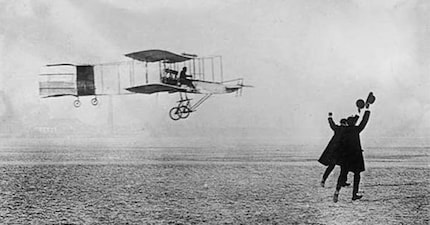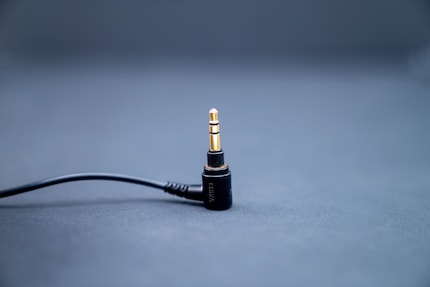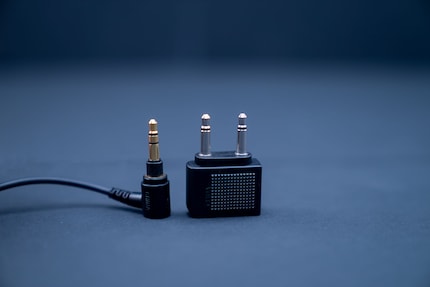
Product test
Sony WH-1000XM3: Silence in the noise. And jingles
by Dominik Bärlocher

Modern headphones come with a mysterious adapter. Reader MakeAppsNotWar believes that it is relevant to aviation. The search for clues leads from the 19th century via the military to Zurich Kloten.
If you buy a modern pair of headphones, such as the Sony WH-1000XM3, you'll get all kinds of accessories. In the review of these headphones, I mentioned a strange adapter. It has two 3.5mm jacks and goes into a normal cable. There was then a discussion in the comments column about what this object is supposed to be good for.
User MakeAppsNotWar suggests the following:
Older models often have radios built into the seat where you can listen to music, or if a film is playing, you get the sound. With the splitter you combine stereo L/R as it was difficult to combine both in one cable back then.
In the comment column, the airline Emirates is also mentioned from time to time, on whose flights the adapter is said to be indispensable. But the readers don't know exactly why.
A 3.5mm jack has a fixed structure. Since time immemorial. Because the technology is not new. The first version of the plug, which we now call the 3.5mm jack or headphone jack, dates back to early telephony. The first records of a plug similar to the one we use today date back to 1877. At that time, the then still 6.35mm thick plug was used for telephone circuits in a shop owned by a certain Charles Williams in Boston as a hinged cabinet or, somewhat more awkwardly, a telephone hand switch.

For comparison: man first took off from the ground in 1903, when the Wright brothers flew 259 metres at a height of three metres in their motorised flyer.
The design of the Jack has remained largely unchanged ever since. It became smaller in the 1950s and the world agreed on the 3.5mm thickness. After telephony, the Jack eventually found its way into the private sector via the military, where it finally made its breakthrough with Sony's Walkman in the 1980s. Incidentally, the SRF article from 1981 on the topic of the Walkman is well worth watching.

Headphone connections were first installed in audio systems in aeroplanes in 1985. This was long after the invention of headphone jacks and plugs as we know them, and around 30 years after the introduction of the common ring system that makes stereo sound possible.
The left/right divide that MakeAppsNotWar refers to is therefore unlikely to apply.
The functionality of a 3.5mm connection is actually quite simple. Put simply, when you insert the plug into the socket, you close a circuit that then generates vibrations in the headphones, which are then picked up by the ear as music.

The connector essentially consists of three elements. The system is known as a TRS adapter. The abbreviation stands for "tip", "ring" and "sleeve", i.e. "shielding".
These three elements provide the stereo sound. As a rule, it works like this:



The TRRS adapter has now become standard for smartphones: Tip, ring, ring, sleeve. The additional ring is used for the microphone signal.

But the mysterious adapter from the Sony XM3 box has two such plugs, both of which are TS - tip, sleeve. This implies two audio channels, each with a mono signal, which are then adapted to a standard TRS connector in the adapter.

This would mean that one plug is "stereo left" and "ground", the other is "stereo right" and "ground".
So MakeAppsNotWar is right after all?
MakeAppsNotWar has stirred up a hornet's nest of history, technology and travelling comfort with its question. So it makes sense to ask the experts. If anyone should know, it's people who deal with aircraft on a daily basis. The inflight entertainment team at Swiss responded to an email with a picture of the adapter and the question "What is it?" as follows.
The picture actually shows an adapter for certain Inflight Entertainment (IFE) systems. This second pin supplies the power for the airline's noise-cancelling headphones (so that no batteries have to be inserted into the airline headphones). If a passenger brings their own headphones, they need this adapter on the IFE systems in order to hear the signal on both ear cups.
Active noise cancelling has been around on paper since the 1950s. According to the company's story, Amar Bose - yes, the Bose - got upset about the noise on a flight in 1978, and active noise cancelling is now in active development.

But it also works without it, because Swiss also provides a life hack.
The alternative (life hack) ... first insert the 3.5mm plug all the way into one of the two plugs and then pull it out a little, but it's a bit annoying with the vibrations in the aircraft, so the adapter makes more sense.
The adapters are now only needed on two Airbus A340s and all A330s. The A340s will soon be converted so that they can catch up with the rest of the A340s. This is because normal 3.5 mm adapters can be connected to these, as well as to Swiss' Boeing 777s.
The result:
Our passengers can plug their own headphones into the 3.5mm plug as normal.
So, that's it. Thanks for the reader question. Never thought it would be such a funny story.
Journalist. Author. Hacker. A storyteller searching for boundaries, secrets and taboos – putting the world to paper. Not because I can but because I can’t not.
Interesting facts about products, behind-the-scenes looks at manufacturers and deep-dives on interesting people.
Show all
Background information
by Dayan Pfammatter

Background information
by David Lee

Background information
by Livia Gamper